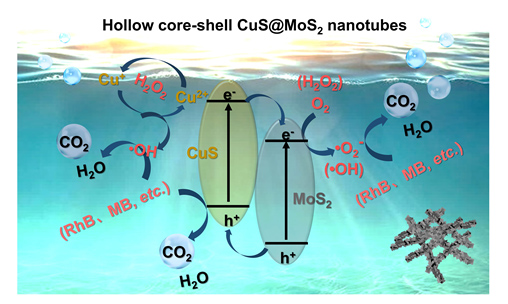摘要/Abstract

采用微波诱导组装,先将Cu纳米线硫化成空心CuS纳米管,再将片状MoS2均匀插层并组装在CuS纳米管表面上,形成CuS@MoS2核壳纳米管,用于可见光(λ>420 nm)催化类芬顿反应降解高浓度污染物罗丹明B(RhB),30 min内降解率达100%.高活性归因于MoS2独特的多层次结构增加了催化剂对光的吸收,提高了光利用率.同时,MoS2与CuS之间形成的异质结结构有利于光生电子的转移,抑制了光生载流子的复合.更为重要的是构建了光催化与类芬顿反应的协同作用机制,光催化组分CuS中的铜离子与双氧水作用构成类芬顿循环体系并生成羟基自由基(·OH),光生电子一方面与双氧水反应生成·OH,另一方面与MoS2活化的分子氧反应产生超氧自由基(·O2-),·OH和·O2-协同氧化污染物,可大幅度提高污染物去除效率.本工作开发的可循环光催化-芬顿反应体系,为实际污染治理开辟了新途径.
关键词: CuS@MoS2, 光催化, 类芬顿反应, 协同作用, 微波诱导自组装
CuS@MoS2 core-shell nanotubes were prepared by microwave-induced assembly techniques in the present work. Firstly, the Cu nanowires were vulcanized into hollow CuS nanotubes. Secondly, the sheet-shaped MoS2 were uniformly intercalated and assembled onto the surface of CuS nanotubes. The as-prepared CuS@MoS2 core-shell nanotubes were used in photocatalytic Fenton-like reaction system to remove high-concentration rhodamine B (RhB) in aqueous solution, which exhibited 100% degradation rate within 30 min under visible light (λ>420 nm) irradiation. The morphology and structure of the as-obtained catalysts were characterized by scanning electron microscopy (SEM), transmission electron microscopy (TEM), energy dispersive X-ray spectrometer (EDS) and X-ray diffractometry (XRD). UV-Vis absorption spectroscopy (UV-vis DRS) was used to characterize its basic optical properties. And to further learn the catalytic mechanism and make sure the active species of the photocatalytic Fenton-like reaction system, the heterojunction structure of the catalyst was analyzed and electron spin resonance (ESR) spectrum was carried to prove the existence of superoxide (·O2-) species. The high activity could be attributed to the unique multi-layer structure of CuS@MoS2, corresponding to the enhanced absorption and exciting ability of visible lights. Meanwhile, the heterojunction structure formed between MoS2 and CuS also promoted the transfer of photogenerated electrons, which could inhibit their recombination with photogenerated holes. More importantly, the cooperation mechanism formed between photocatalysis and Fenton-like reactions may exhibit strong promoting effect. The Cu2+ ions in CuS reacted with H2O2 to form a Fenton-like cycle, allowing the generation of reactive hydroxyl (·OH) species. While, the photogenerated electrons reacted with both the H2O2 and the molecular oxygen activated by MoS2 to produce ·OH and ·O2- species. Both ·OH and ·O2- species worked together to oxidize pollutants rapidly. This work developed a recycled photocatalytic Fenton-like reaction system, which may offer new pathway for the treatment of environmental pollution.
Key words: CuS@MoS2, photocatalysis, Fenton-like reaction, synergistic effect, microwave-induced self-assembly
PDF全文下载地址:
点我下载PDF
